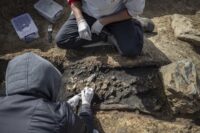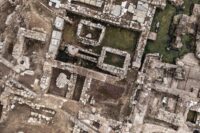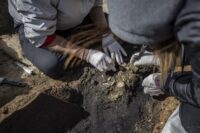 Archaeologists have unearthed a 3rd century B.C. cremation burial in an excavation at Istanbul’s Haydarpaşa Train Station. The brick tomb was found to contain cinerary remains and charred grave goods.
Archaeologists have unearthed a 3rd century B.C. cremation burial in an excavation at Istanbul’s Haydarpaşa Train Station. The brick tomb was found to contain cinerary remains and charred grave goods.
According to the preliminary analysis, the body was cremated inside the tomb, but the skeleton and other remains survived the blaze and have now been unearthed, [Rahmi Asal, director of the Istanbul Archaeological Museum] explained.
He said a terracotta goblet and a perfume bottle, both of them with visible marks of fire damage, were found with the skeletal remains.
“I have never seen this type of a cremation tomb from the Hellenistic period … Perhaps this will give us many more valuable insights,” he added.
 The area around the historic train station has been excavated since 2018. Now a neighborhood on the Asian side of Istanbul, the site was part of the ancient Greek city of Chalcedon which was founded by colonists from Megara in the 7th century B.C., predating the founding of Byzantium by almost two decades. Its fortunes were entwined with Byzantium’s for centuries, but after Constantinople became the new capital of the Roman Empire, Chalcedon was eclipsed. The Byzantine Empire and the Ottoman Empire that followed it both used Chalcedon as a quarry for their building programs.
The area around the historic train station has been excavated since 2018. Now a neighborhood on the Asian side of Istanbul, the site was part of the ancient Greek city of Chalcedon which was founded by colonists from Megara in the 7th century B.C., predating the founding of Byzantium by almost two decades. Its fortunes were entwined with Byzantium’s for centuries, but after Constantinople became the new capital of the Roman Empire, Chalcedon was eclipsed. The Byzantine Empire and the Ottoman Empire that followed it both used Chalcedon as a quarry for their building programs.
 The four years of digs have revealed archaeological layers from the Ottoman, Byzantine, Roman, Hellenistic and Classical eras, including more than 2,000 coins, a Roman defensive wall, a Middle Byzantine ceramic brick kiln and the only functioning Byzantine-era fountain in Istanbul. The cremation burial is only the second find from the city’s Hellenistic period. The other was a podium made of rectangular stone blocks clamped together with iron clasps found under the railway platforms.
The four years of digs have revealed archaeological layers from the Ottoman, Byzantine, Roman, Hellenistic and Classical eras, including more than 2,000 coins, a Roman defensive wall, a Middle Byzantine ceramic brick kiln and the only functioning Byzantine-era fountain in Istanbul. The cremation burial is only the second find from the city’s Hellenistic period. The other was a podium made of rectangular stone blocks clamped together with iron clasps found under the railway platforms.
Chalcedony, as a cryptocrystalline form of silica, derives its name from Chalkedon. However, ‘Kadıköy’ as part of what today is Istanbul seems to have been bowdlerized to ‘Village of the Judge’, while ‘Istanbul’ is itself a corruption of the Greek εἰς τὴν Πόλιν –’eis ten Pólin’/ “to the City” –used back then for ‘Constantinople’, a.k.a. Byzantion.
Apparently, the oracle in Delphi told those colonists to build their city “opposite to the blind”, and according to Herodotus in the 5th century BC:
“For being once at Byzantion [the Persian general Megabazos], having heard that the men of Chalcedon had settled in that region seventeen years before the Byzantians, said that the founders of Chalcedon must have been blind, for they would not have chosen the clearly worse place.” 😎
Hi Sophie,
What is the source for naming Istanbul ? Is it just your assumption?
:boogie: :boogie: :boogie:
“Even old New York was once New Amsterdam
Why they changed it, I can’t say
People just liked it better that way.
Why did Constantinople got the works?
That’s everybody’s business and the Turk’s”
:boogie: :boogie: :boogie:
Brusk, there are plenty of sources and it is also what they told me back in school. The Greek and the ‘-bul’/ ‘Polis’/ Πόλιν bit, however, can be taken for granted. There was also one claim that the first bit was a leftover of (Constan)stin(o) Poli(s), i.e. ‘Constantinopolis’.
:hattip:
The national public broadcaster of Turkey, TRT, claims that one of the colonists that followed the Delphi oracle had been a guy named ‘Byzaz’ (hence, ‘Byzantion’). Septimus Severus had dubbed it –after his son– ‘Augusta Antonina’, then ‘Secunda Roma’. Islamic sources also referred to it as Rûmiyyetü’l kübrâ“ (Greater Rome), „Taht-ı Rûm“ (Seat of Rome). ‘Constantinopolis’ was also referred to as „Konstantiniyye“. Then, TRT points out that there was ‘Stan’ and ‘Pol(is)’.
———-
“Locals of Constantinople referred to the city as I Sten Pol (within the city [εἰς τὴν Πόλιν]) from the 10th century, which is also attested in Armenian and Arabic sources (without the original I-) and in Ottoman sources. The “I Sten Pol” eventually merges into one word, according to Marek Stakhovsky and Robert Woodhouse. They are the authors of “The Etymology of Istanbul: Making the Best Use of the Evidence.” In summary, the Greek usage of Constantinople to mean “the city”.
“When the Ottomans conquered Istanbul, they by and large retained the old Greek names such as Bosporus, Üsküdar and, of course, Hagia Sophia,” Ahmed adds. Renowned historian Halil İnalcık says Ottoman Sultan Mehmet II tried to establish the name Islambul. The name was applied but never made official, he said.
“In reality, the Ottomans were satisfied with the Ottoman or Arabized name of Constantinople, which they called Konstantiniyye. They also had other names such as Pay-i Taht (capital) and Asitane, but these were never officially used,” Ahmed explains.
The most common name of the city during the Ottoman era was Konstantiniyye, the Arabic version of Constantinopolis. The city was also called “Dersaadet” (the city of happiness) or “Asitane” – after the large dervish monastery – another expert claimed in 2012. Ottoman sultans did not stick to names – but there was one exception. “Sultan Mustafa the Third used Islambol, ‘City of Islam,’ in his imperial writings.”
Back to the Greek root: the root of “Istanbul” in Greek is “Stinpolis” and, as mentioned above, means something like “to the city.” “City” here refers to a town within city walls. “At that time, they never called the places without city walls Istanbul. That is the main mistake nowadays. When they say ‘the other side,’ they never refer to Kadiköy (in the Asian part), but to Galata. When they refer to crossing to the other side, they mean from Karaköy to Galata or from Galata to Kuledibi. There is no Taksim and no Üsküdar at that time. And there are seasonal prince islands and villages on the Bosphorus. That is, the Bosphorus is not considered Istanbul,” explained the expert”.
———-